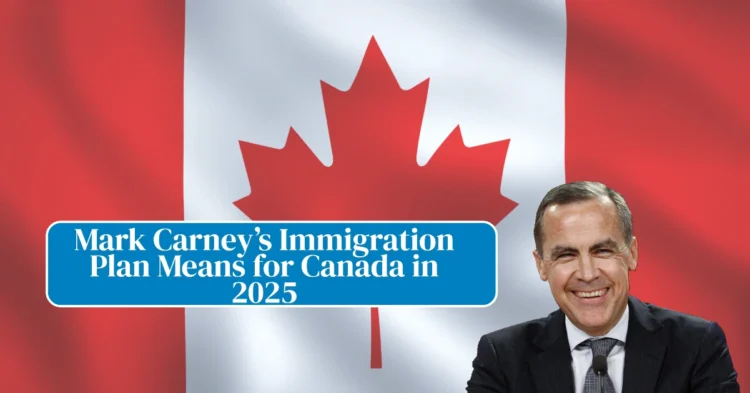Canada is entering a transformative chapter in its immigration history under the leadership of newly elected Prime Minister Mark Carney. Following the Liberal Party’s victory in the 2025 federal election, Carney—who succeeded Justin Trudeau—has laid out a comprehensive and balanced immigration vision for the country.
Table of Contents
With a minority government and shifting public sentiment around immigration, the Liberals have pledged to stabilize the system by aligning policy with infrastructure, economic needs, and demographic realities.
A Turning Point in Canada’s Immigration Strategy
Mark Carney’s leadership signals a shift from aggressive population growth strategies to a more sustainable model. During his campaign, Carney promised to “get back on track” by addressing the challenges brought on by a rapid influx of newcomers post-COVID, including strain on housing, healthcare, and public services.
While upholding Canada’s reputation as an open and inclusive country, Carney’s approach introduces a pragmatic framework focused on managing immigration levels responsibly.
Liberal and Conservative Immigration Plans Compared Ahead of 2025 Election
Canada Increases Immigration Fees for Temporary Residents Starting December 1
Canada’s Immigration Backlog Sees a Decrease, According to New IRCC Update
Quebec New Immigration Cap for 2024-2025: Overview of Changes and Implications
IRCC Extends Public Policy for Immigration Medical Examination Exemptions until 2029
Stabilizing Permanent Residency Admissions: A Sustainable Cap
One of the major cornerstones of the Liberals’ 2025 immigration plan is the commitment to keep annual permanent resident admissions below 1% of Canada’s total population starting in 2027.
This means continuing with reduced annual targets:
- 395,000 PRs in 2025
- 380,000 in 2026
- 365,000 in 2027
This stands in stark contrast to previous ambitions under Trudeau to reach 500,000 admissions by 2025. By emphasizing long-term integration and reducing pressure on housing and social services, this policy creates a more predictable and manageable immigration pathway for new Canadians.
Reducing Temporary Resident Numbers: A Return to Equilibrium
As of early 2025, Canada hosts over 3 million temporary residents, representing 7.25% of the national population. Carney plans to reduce this figure to below 5% by 2027, primarily by:
- Limiting study permit applications
- Tightening work permit eligibility
- Restricting spousal open work permits
- Encouraging the transition of qualified temporary residents to PR
This shift acknowledges the unsustainable growth of temporary immigration, particularly in education and labor sectors, and seeks to balance the short-term economic needs with long-term system stability.
Empowering Francophone Communities Outside Quebec
To strengthen French-speaking minority regions, the Liberals plan to increase francophone immigration targets to 12% by 2029, rising steadily from:
- 8.5% in 2025
- 9.5% in 2026
- 10% in 2027
This initiative focuses on supporting cultural diversity and demographic renewal in provinces like New Brunswick, Manitoba, and Ontario. With enhanced programs and funding for francophone immigrants, the plan positions French-speaking newcomers to thrive across Canada.
Prioritizing Economic Immigration: Skilled Talent at the Core
Economic immigration will continue to dominate PR allocations—projected to make up 62% of total admissions by 2027. The Liberals aim to:
- Strengthen the Global Skills Strategy, speeding up work permits for in-demand sectors
- Partner with provinces to streamline foreign credential recognition, particularly in healthcare and skilled trades
- Attract skilled U.S. workers seeking better immigration prospects
For tech workers, healthcare professionals, and tradespeople, these updates offer faster routes to permanent residency and meaningful employment in Canada’s economy.
Digital Transformation, Border Integrity, and System Fairness
To modernize immigration processing and enhance fairness, the Liberals propose:
- Expanding digital processing tools to cut down backlogs and wait times
- Enhancing legal aid for asylum seekers
- Increasing resources for border security and immigration fraud enforcement
- Collaborating with Quebec to respect provincial autonomy in immigration levels
These administrative reforms aim to reduce inefficiencies while maintaining a fair and secure immigration system for all applicants.
Why These Changes Are Timely and Necessary
Between 2021 and 2024, Canada experienced explosive growth in its temporary resident population, straining key sectors. Public opinion has since shifted, with many Canadians demanding a more controlled approach to immigration. A 2025 Angus Reid poll found most respondents favored lower immigration targets due to affordability and service capacity concerns.
Carney’s policies aim to meet these concerns without sacrificing Canada’s demographic and economic imperatives—particularly in light of an aging population and low birth rates.
What This Means for Immigrants, Students, and Canadians
For immigrants already in Canada, the policies offer more clarity and opportunity to gain permanent residency. However, prospective international students and workers will face stricter criteria.
Skilled professionals in sectors facing labor shortages will benefit from streamlined credential recognition and faster processing. Francophone immigrants will find increased support and settlement programs in minority-language communities.
For Canadians, this immigration strategy is intended to ease pressure on housing and public services, while still supporting economic vitality through targeted immigration.
Challenges Ahead: Striking the Right Balance
Despite the ambitious vision, implementation will not be without challenges. The Liberals must:
- Expand housing and healthcare access to keep pace with immigration
- Ensure fair access to PR spots for vulnerable groups like refugees and families
- Collaborate effectively with provinces and stakeholders
Carney’s vision requires careful execution to avoid bottlenecks, while keeping Canada competitive in the global race for talent.
A Vision Rooted in Growth, Stability, and Inclusion
Mark Carney’s 2025 immigration plan reflects a careful rebalancing of Canada’s priorities. By reducing temporary influxes, enhancing economic pathways, and embracing linguistic diversity, the Liberals are setting a course that emphasizes quality over quantity.
This pragmatic yet inclusive strategy acknowledges Canada’s challenges while protecting its identity as a global leader in humanitarian and skilled migration.

